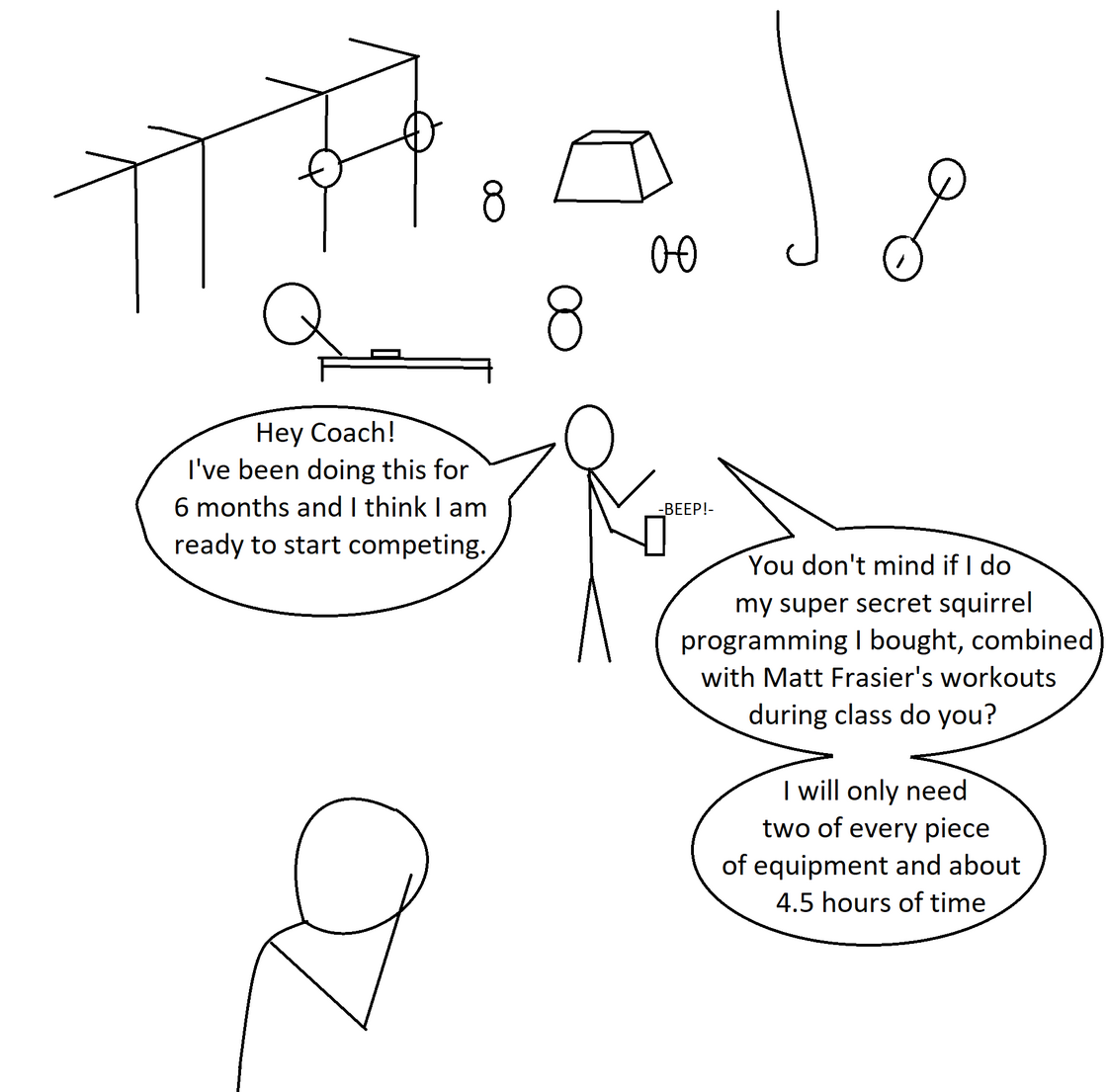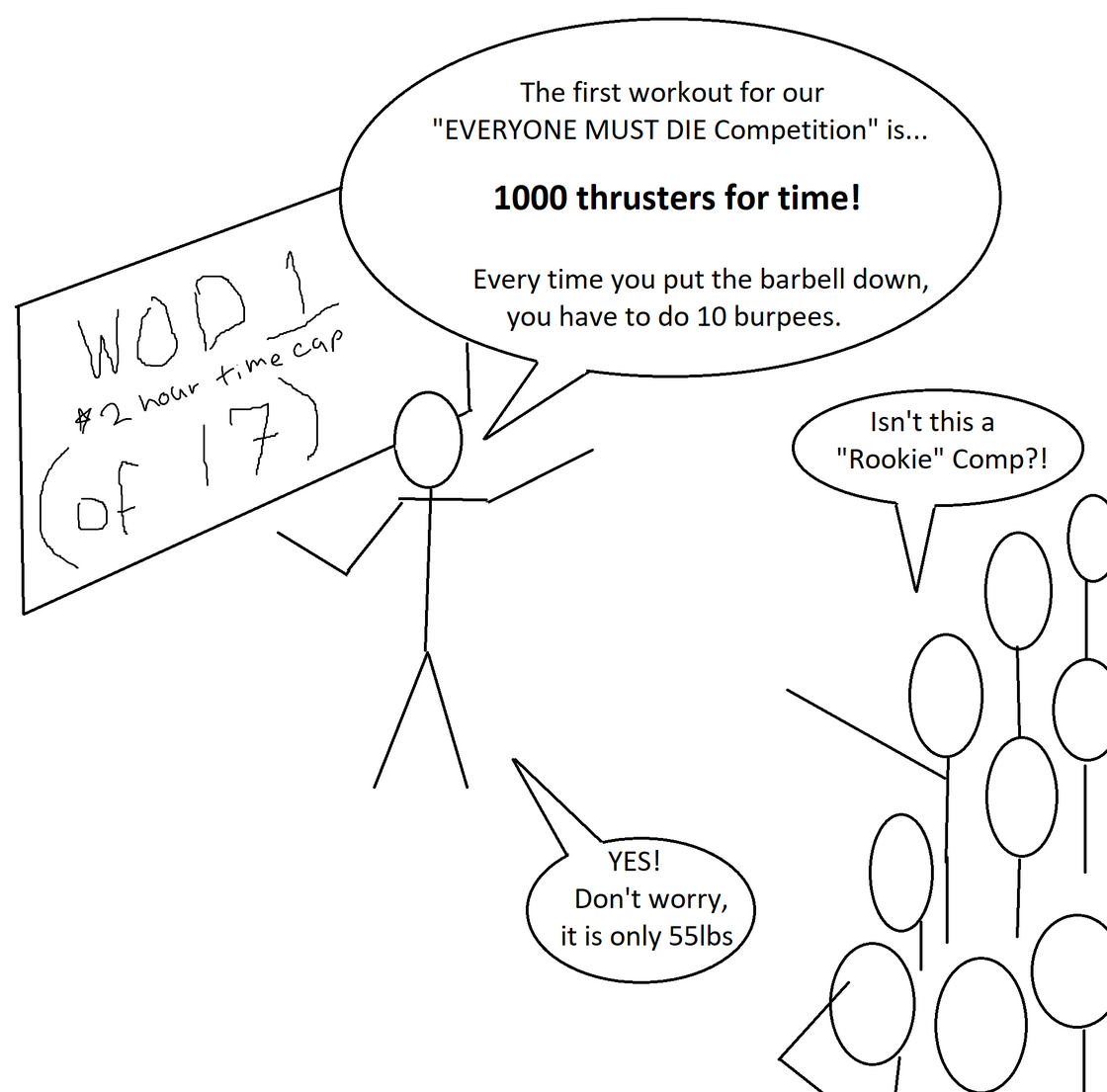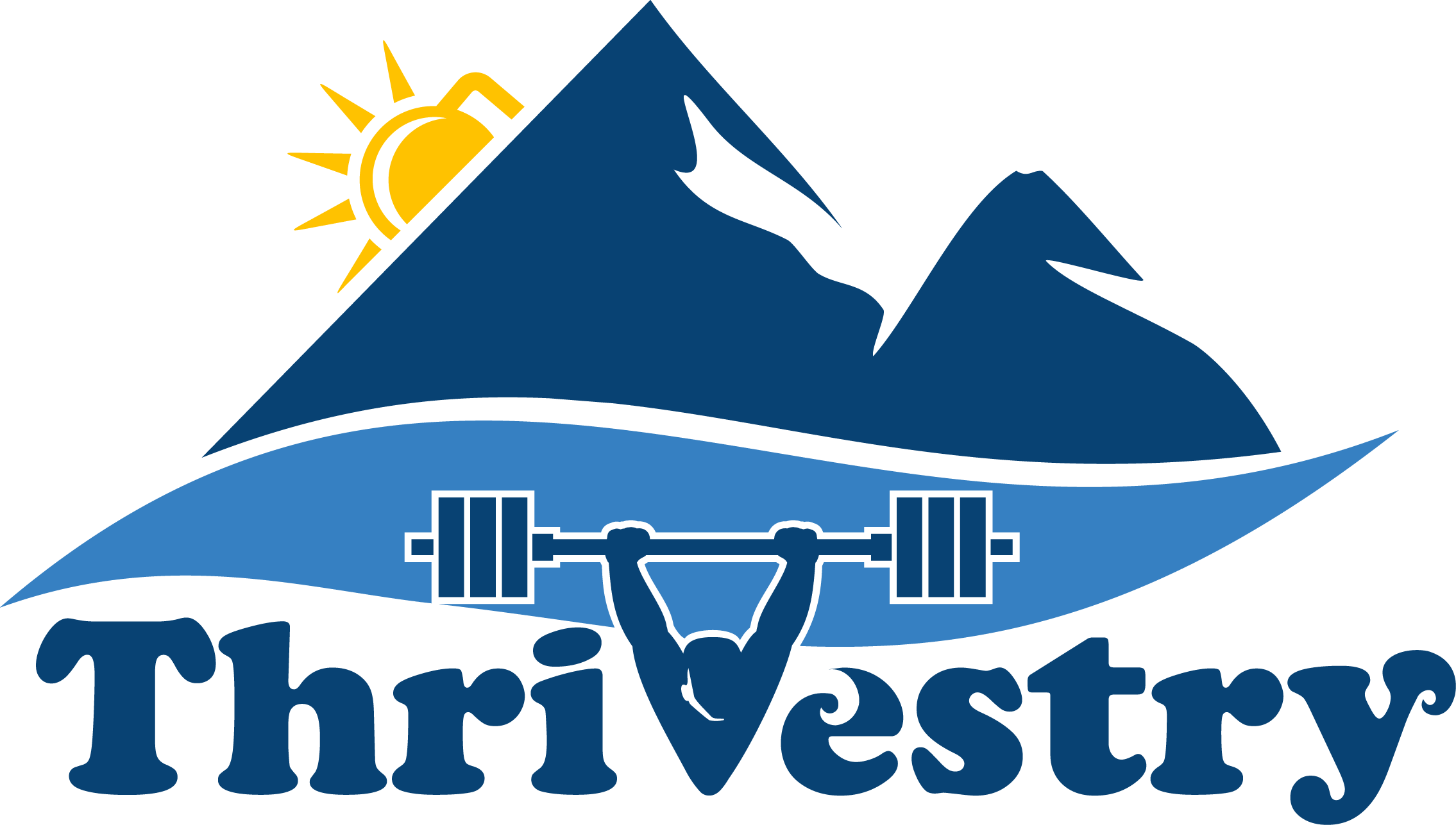Getting Ready for Competition (Part 1)
“I think I want to compete someday, do I need special programming?”

First, I think it is important to point out that regular gym programming is designed to get you fit, keep you safe, and have some fun along the way. It is designed to challenge people from the beginning level to people who have been doing it for decades.
It is not focused ONLY on competition in functional fitness events!
That said, many people who show up consistently, scale accordingly, and listen to their coaches, will end up doing pretty well in the CrossFit Open and even local competitions (that are programmed intelligently).
(Not like this:) 
But there is a point at which the needs of competition differ greatly than what is going to be best for regular folks only coming into the gym 3-4 days per week, just want to look good at the beach, and/or like to feel good/strong so they can do things outside of the gym.
Years of experimentation, and years of consistent training, have made the top competitors (people making Regionals and the Games as individuals) have abilities that far exceed what can be achieved by just doing regular classes for a few years (this wasn’t the case in 2007-2011 or so).
Combine that with the fact that there are many movements and skills in competition that are not going to make you more ‘fit for life’ and that have a high risk-to-reward ratio. Things like large sets of chest to bar pull ups or walking on your hands over obstacles.
Side Note: The first-time chest to bar pull ups showed up in any major CrossFit workout was at the 2008 CrossFit Games. People were just beginning to do a more ‘circular’ version of the pull up (later to be known as the ‘butterfly pull up’ but it wasn’t called that yet), and judges were having a tough time seeing if the chin was above the bar… Not to mention that many people weren’t getting their chin above the bar… It blew our minds when Greg and Lauren (the founders of CrossFit) announced that we’d be doing “Fran” with this new pull up variation! Everyone competing had to adapt very quickly!
The chest hitting the bar was to make it easier to judge, it was not supposed to become the ‘new standard’ for pull ups or be considered a ‘better’ pull up. This movement was invented for functional fitness competition. Regular folks shouldn’t worry about it until they have been doing this stuff for years. And even then, they shouldn’t put any real emphasis on them over other variations like chin ups and strict pull ups!
“Does that mean that regular classes are useless for competition?”
NO!
While the regular classes are designed more for general physical preparedness (GPP), we are still working on many of the same skills and energy pathways that people competing will need to be prepared for a competition. Our regular programming is designed to prepare you for many different things like hiking, doing a Spartan Race, learning to surf, helping your softball team, AND… enter a local ‘rookie’ comp or do the CF Open.
We are still going to work on some of those ‘competition’ skills to keep things interesting as you get more and more advanced (things like handstand push ups, squat snatches, muscle ups, etc.). These are not skills that you need to master to be super fit and healthy, but they are good movements to challenge your abilities and make sure you don’t get ‘bored’ once you have mastered the basics (And they are fun to show off with and impress your friends)!
The Primary Phases from beginner to competitor
There are about 5 phases that people go through on their way to competitions and beyond.
- Phase 0: Coming to class consistently and just learning the movements.
- Phase 1 aka “Novice Competitor”: Doing the majority of the workouts at the Performance level and doing a bit of extra work.
- Phase 2 aka “Amateur”: Doing competition programming in a group while being coached
- Phase 3 aka “Semi Pro”: Still training with others and getting coached, but getting some custom coaching/programming
- Phase 4 aka “Pro”: Getting custom programming and coaching, possibly training alone often
Today we are going to focus on Phase 1 the “Novice Competitor”. The point at which most people start getting ready for competitions.
Phase 1: “How do I get from regular classes to where I feel prepared for competition?”
The first step is to come to regular classes consistently 5-6 times per week. It is best if you can follow the Thrivestry standard: Come no more than 4 days in a row and avoid more than 2 days off in a row. Usually this means 3 on, 1 off, or it can mean 3 on, 1 off, 2 on, 1 off (for a consistent schedule week to week).
If you are constantly challenging yourself, focusing on form and progressions, and getting good recovery/nutrition, you will get to the point at which you’ll be able to do all of the metcons at the “Performance” level. This may take a year, or it may take 5 years. It will depend on where you were at when you started (you background, etc.), how consistent you are with your training, and how good you are at listening to your coaches.
Side Note: If you are considering competition as something you might be interested in, it is important that you put a bit more emphasis on the strength days. Find out what days of the week we are doing the strength focus and other lifts and try to come in on those days. Make up the lifts regularly if you miss them.
It isn’t that strength is more important than metcon or gymnastics skills. It is that strength takes YEARS to develop, and there is no way to accelerate it. And being stronger generally makes other skills easier to master. When people ‘wait’ to work on strength (usually because they have more ‘fun’ doing other things they are good at), they end up not strong enough to be competitive on the heavy events or on the heavy metcons. Start building up your strength as soon as possible so you are ahead of the curve.
As you are approaching the Performance level, you should be able to do most, if not all, of the advanced skills in the skill practice portion of the class (things like rope climbs, hspu, etc.). Your lifts should be on the higher side for your size (1.5x bodyweight back squat, clean and jerk bodyweight for reps, etc.). And you should start doing the “scale up” options regularly. Not necessarily all the time, but you should find that you MUST scale up some of the workouts to end up in the middle of the scaling guide (and not beating it).
Doing ‘extra’ work
It is usually at this time that you’ll have a pretty good idea of what your ‘weakest’ movements are. Sometimes we call these your “Goats”. These are the movements that lag far behind the rest of your skills and can ruin a great performance when combined with even your best stuff.
You will want to spend extra time before and after class working on these ‘goats’. Show up early and do some extra shoulder mobility/prehab. Stay after and practice box jumps or ring dips. Practice double unders at home every day until they become easy (they can… I swear!).
You don’t need to worry about special ‘competition programming’ until you have spent some time at this stage.
Days “off” are also a time to do some extra work. Practice skills or do some low intensity recovery work (easy trail run, play basketball with some friends, etc.)
Here is a summary:
- Come to the gym 5-6 times per week.
- Come to class early to work on weaknesses/skills.
- Always focus on form and efficiency. Take the ‘skill practice’ seriously to get those nailed down.
- Lift heavy, and make sure you are getting the lifts in each week.
- Do the workout at the Performance level and scale up the metcon regularly (when appropriate).
- Stay after to work on more skills (and/or do the cash out/hypertrophy).
- Stay active on ‘off’ days with easy activity and skill work.
Some thoughts on psychology and training on your own ‘special’ program
Generally, it is at the beginning of this phase that some people start searching for a ‘better program’.
They’ll look at what the top competitors are doing on Instagram. They’ll try a few workouts that someone posted online or let you download for free. They may even start paying for ‘competition’ programming or pay for someone to ‘program’ for them (I use quotes because many of the internet coaches out there have not actually coached anyone to the Regionals or the Games).
Usually this is because of frustration and/or a desire to speed things up. To find a shortcut… They ask themselves “How am I going got get better than the other people here if we are all doing the same program?”
While it is great that they are trying their best to get better, this is usually a big mistake that I know YOU aren’t going to make… right!?
One of the biggest problems with going off into the corner and doing their own thing is that they aren’t being coached. There isn’t someone watching them and giving them feedback on form and pacing. There isn’t someone pushing them when they are slacking or holding them back before they get hurt.
I have seen this countless times. People think they need special programming. They go off on their own for 6 months or a year and train mostly by themselves. Their technique barely improves (or gets worse). They don’t have people pushing them. They get tweaks or injuries because nobody is watching them…
They come back to their old training partners and now they are even more behind the people who stuck together.
The other big problem is that most of the ‘competition programs’ out there are designed for really advanced folks. People trying to jump in on these programs too soon will, at best: wash out and not make any progress, or at worst: get hurt.
YOU aren’t going to do that. YOU are going keep coming to class and just layer on your own skill work and strength work (where needed)!
A better use of your time and resources
Instead of paying for programming or remote coaching, you are going to do some one-on-one training with a coach at your gym or do a specialty clinic. The coach is going to give you drills and homework to help you get better much faster. Then you are going to do follow up sessions with your coach to keep you accountable and to keep you making the fastest results possible.
BONUS – Training Partners
This is also the time that you should be finding training partners to help keep you motivated and to push you. Try to come to class together as much as possible. If your schedules don’t work, at least try to make it on the weekend to train together and make sure you are checking each other’s scores the rest of the week.
Think of your training partners the way that fighters do. Technically you are competing with them, but they are also one of the most powerful resources for making you better. “Iron sharpens iron.” In most cases, the better your training partners, the better you’ll be. It can be frustrating when they beat you, but you want them to get better, so you can get better!
(Incidentally, this is ANOTHER reason why doing your own program in open gym isn’t a good option)
BONUS BONUS – Specialty Classes
Many gyms will offer specialty classes to help you work on things like barbell lifting, gymnastics, running, etc. These are an additional class that can be 1-3 times per week where you get to spend the time focusing on a specific area of training. If you know that you have a weakness in this area, Phase 1 is a good time to take advantage of these programs. Don’t miss these opportunities!
The Next Phase
After you have spent some time in Phase 1 (usually about 3 months to a year), you might be ready to start going to a competition class. We cover that in Part 2 of this series!
Thrive on.
-jj

0 comments
Leave a comment